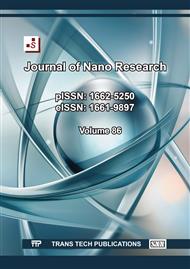p.1
p.15
p.33
p.43
p.51
p.57
p.67
p.77
p.89
Structural, Morphological and Optical Investigations of Pure and Iron Doped Manganese Sulfide Thin Film by Chemical Bath Deposition
Abstract:
Thin films of pure and iron doped MnS, have been deposited on glass substrates using a straightforward and cost-effective technique named Chemical Bath Deposition (CBD). The temperature of the heating water bath was maintained at 90°C for three hours of deposition. Deposition is done by varying the doping concentration of Fe from 0 to 10%. Manganese chloride, iron chloride tetrahydrate, urea, and thioacetamide were the precursors employed in this work. The X-ray diffraction method was used to ascertain the thin film's structural properties. Using the Scherrer formula, the average crystallite size for an undoped MnS thin film was observed to be 30.28 nm and is decreased to 24.02 nm for 4% of Fe doping. For an undoped MnS thin film, the values of dislocation density and material strain were 1.09× 10−3(𝑛𝑚)−2 and 3.418× 10−3, respectively. These values were increased to 1.73× 10−3(𝑛𝑚)−2 and 4.65× 10−3, respectively due to decrement in the crystallite size. Grain size and morphology were examined using Scanning Electron Microscopy (SEM). Micrographs of samples were obtained at different magnifications and their values were noted as 0.9 μm for pure and 4.69 μm for 4% Fe doped thin films. Optical properties were determined using DRS method. The energy band gap was found as 2.21 eV for pure samples and it was decreased to 2.14, 2.09, 1.98, 1.96 and 1.93 eV for 2, 4, 6, 8 and 10% iron doping, respectively. Solar cells, solar selective coatings, sensors, optical mass memory, and anti-reflection coatings have all made substantial use of MnS thin films.
Info:
Periodical:
Pages:
51-56
Citation:
Online since:
December 2024
Authors:
Keywords:
Price:
Сopyright:
© 2024 Trans Tech Publications Ltd. All Rights Reserved
Share:
Citation:



